In case your time is short
- Most law firms invest heavily in legal tech but overlook the 24×7 infrastructure monitoring and incident management needed to keep it running without disruption.
- Network downtime costs more than billable hours—it erodes client trust. This guide explains why traditional IT support often falls short for legal, what “legal-grade” network operations look like, and how advanced, AI-driven incident management can protect your systems, security, and reputation.
- INOC has spent over 20 years perfecting 24×7 network operations for mission-critical industries—including law firms where uptime, security, and responsiveness can’t be compromised.
- Our US-based engineers and AI-driven Ops 3.0 platform deliver faster incident resolution, proactive monitoring, and legal-grade security controls that protect your billables and your reputation. Whether augmenting your IT team or providing full NOC coverage, INOC keeps your infrastructure—and your firm—running without interruption.
Every minute your firm's infrastructure is offline costs more than billable hours. It costs client confidence. And in the legal world, that's a currency you can't afford to devalue.
We've spent over two decades building and refining a network operations center service, and here's what we've learned: most law firms are operating with a critical gap in their technology strategy.
They've invested heavily in document management systems, practice management software, VDI environments, and all the mission-critical legal tech that keeps modern firms running. But what they're missing is the protective layer that prevents small issues from cascading into business-stopping outages.
Think about it:
- When your document management system goes down at 10pm—right when that associate needs to pull precedents for tomorrow's filing—who's fixing it?
- When partners can't access case files remotely during critical negotiations, how many minutes of downtime can you really tolerate?
These aren't just IT headaches. They're business problems that directly impact your bottom line and your reputation.
Why Traditional IT Support Falls Short for Law Firms
Most managed service providers—even in 2025—weren't built for the specific demands of legal-grade infrastructure. They're generalists trying to apply broad solutions to an industry that operates at a different speed and with different stakes.
But having worked with global law firms, we know firsthand that legal work doesn't stop at 5pm. It doesn't pause for weekends. When you're dealing with filing deadlines, international transactions, or time-sensitive litigation, you need infrastructure support that matches your operational tempo. And frankly, that's not something you get from providers who are also managing dental offices and retail chains.
|
The legal industry has unique infrastructure demands:
|
Understanding the Real Scope of Legal IT Infrastructure in 2025
Let's quickly paint you a picture of what we're really talking about when we discuss legal-grade infrastructure monitoring.
This isn't just about keeping your email server running anymore.
The visible layer (what everyone thinks about)
|
The foundation layer (what actually keeps you running)
|
Each of these layers needs continuous monitoring, proactive management, and immediate response when issues arise. They all need to work together seamlessly—24x7x365.
![]()
The Advanced Incident Management Difference
I want to share something we've developed over the years that fundamentally changes how infrastructure support works. We call it Advanced Incident Management (AIM), and it's the opposite of how most NOCs operate.
Let me break it down quickly:
- Traditional NOCs work like this: an alert comes in, it goes to a tier 1 technician who may or may not understand its significance, they escalate to tier 2, who might escalate to tier 3, and by the time someone who actually understands the problem sees it, you've lost precious time.
- We flipped that model. Our senior engineers review every alert first. They understand the context, the dependencies, and the business impact immediately. Then they either resolve it themselves or route it to the exact right resource—no bouncing between tiers, no game of technical telephone.
Here's what that means in practice: When 20+ alerts fire because your primary WAN link fails, we don't create 20 tickets. Our AI-powered correlation engine recognizes the pattern, our senior engineer validates the root cause, and we create one ticket that goes directly to the person who can fix it. Meanwhile, we're already executing your runbook procedures and notifying the right people in plain English about what's happening and when it'll be resolved.

The Power of AI-Driven Operations
Let me cut through the AI hype and tell you what we're actually doing with AIOps in production right now, and then a little of what we're working on.
AI-driven event correlation and noise reductionThe most fundamental problem in infrastructure monitoring isn't detecting problems—it's dealing with the avalanche of alerts that modern infrastructure generates. A single root cause can trigger hundreds of alerts across multiple systems. Without intelligent correlation, you're drowning in noise. Our NOC has been doing this for years—taking thousands of raw events and correlating them into actionable incidents. When your primary database server has an issue, it might generate alerts from the database itself, the application servers trying to connect to it, the web servers experiencing timeouts, the load balancers detecting unhealthy nodes, and monitoring systems detecting service degradation. Instead of creating 50 tickets, our correlation engine recognizes the pattern. It understands the relationships between your infrastructure components—what depends on what, what typically fails together, what's a symptom versus what's a cause. The result? One ticket, with the right priority, routed to the right team, with all the context needed to resolve it. |
Automated root cause analysisWhen multiple systems are alerting, determining the root cause quickly is critical. Our AIOps platform doesn't just correlate events—it performs automated root cause analysis by:
For example, when network latency spikes coincide with database timeouts and application errors, the system can determine whether the network is the cause or just another symptom of an overloaded database server. It does this by analyzing the sequence of events, the severity patterns, and the historical relationships between these components. |
Predictive analytics and anomaly detectionWe're not just reacting to problems, we're predicting them. Our platform continuously analyzes trends to identify issues before they impact services:
A real example: We identified a memory leak in a client's application server two weeks before it would have caused an outage. The memory usage was increasing by just 0.5% per day—too gradual for traditional threshold alerts, but our trend analysis caught it and allowed for a planned fix during a maintenance window. |
Intelligent automation and self-healingThis is where AIOps really proves its value. We've automated the resolution of common issues that have clear, safe remediation steps:
This isn't blind automation. Each automated action is governed by careful controls:
|
Dynamic thresholdingStatic thresholds are obsolete. Is 80% CPU utilization bad? Depends—it might be normal during your batch processing but critical during business hours. Our AIOps platform uses dynamic thresholding that adjusts based on:
The system learns what's normal for each metric in each context and alerts only when there's a meaningful deviation that could impact service. |
Here's a quick high-level rundown of some of the recent GenAI projects we're working on right now—in addition to the AIOps capabilities we already have throughout our NOC operation. Talk to us for a deeper dive.
Incident summarizationWhen you've got a ticket that's been running for weeks with hundreds of lines of notes, we're working on AI that creates an executive summary. Instead of spending 10 minutes reading through the entire history, our engineers understand the current state and next actions in seconds. It's not replacing human judgment—it's augmenting it. |
Intelligent resolution notesAt the end of an incident, we're training our AI to review the entire ticket history and generate candidate resolution notes. Our engineers will be able to review, refine, and approve them. The result? Clear, consistent documentation that actually helps prevent future issues. And here's the thing—good technical people aren't always eloquent writers. The AI helps bridge that gap, ensuring every resolution is clearly articulated. |
Adaptive communicationThis is where it gets really interesting. We're implementing systems that adapt our communication based on who we're talking to. When we're working with your senior network architect, we can get technical. When we're updating your office manager about a printer issue, we keep it simple and actionable. Same information, right-sized for the audience. |
Knowledge article generationWhen we resolve a particularly interesting problem, our AI can generate a knowledge article from the incident. It's not automatic—our engineers review and refine it—but it means we're constantly building our knowledge base from real-world resolutions, not theoretical scenarios. |
AIOps isn't just about smart algorithms—it's about making all your tools work together intelligently. Our platform integrates with:
- Your existing monitoring tools (we don't replace them, we make them smarter)
- Your ITSM platform if you use one (tickets are created, updated, and resolved automatically)
- Your communication systems (the right people are notified in the right way)
- Your infrastructure APIs (for automated remediation and data collection)
This integration layer is what transforms AIOps from an interesting concept into operational reality.
Building Security Into Every Layer
Security in the legal industry isn't optional—it's existential. One breach, one leaked document, one compromised communication, and you're not just facing technical problems. You're facing bar complaints, malpractice claims, and irreparable reputation damage.
That's why our security approach goes far beyond industry standard:
- Complete Data Isolation: Every client's data is completely segregated—connectivity, servers, databases, reporting. We're not just using virtual separation; we're using physical and logical isolation at every level. Your data never mingles with another firm's, period.
- Personnel Security: Every single person who touches your infrastructure has passed a 7-year background check, including drug screening. This isn't just about checking boxes—it's about ensuring that the people responsible for your firm's digital infrastructure are as trustworthy as the attorneys handling your most sensitive matters.
- Compliance and Certification:
- ISO 27001:2022 certified: This isn't a participation trophy. It's a rigorous international standard that requires continuous improvement and regular audits
- SOC 2 Type II: Dual primary data centers with complete redundancy
- Secure facilities: Physical access control, keycard systems, comprehensive audit logging
- The US-Based Difference: Let me address something directly. There's a place for offshore IT support in many industries. Legal isn't one of them. When you're dealing with client confidential information, when every communication could be subject to privilege, when data sovereignty matters—you need to know exactly where your data is and who's accessing it.
Our operations are US-based. Our engineers are US-based. Your data stays in the US. No exceptions, no fine print.
The Platform Approach: More Than A Room with Some Tools
Over the last 20 years, we've built what we call the Ops 3.0 platform. It started as our internal system for delivering NOC services, but it's evolved into something much more significant.

This isn't just a collection of monitoring tools stitched together. It's a purpose-built platform that enforces best practices, drives consistent processes, and delivers measurable outcomes. And here's the key—the platform and the processes are inseparable. They were designed together, refined together, and they only work when used together.
What the platform actually does
- Intelligent correlation: Thousands of events become actionable tickets
- Automated runbook execution: Common issues are resolved without human intervention
- Predictive analysis: We spot trends before they become problems
- Complete visibility: Every action, every change, every access is logged and auditable
But the platform is just the foundation. What makes it powerful is how we've built our entire operational framework around it.

Scalability That Matches Your Growth
Law firms grow in unique ways. You might acquire another firm tomorrow. You might open three new offices next quarter. You might spin off a practice group next year. Your infrastructure support needs to flex with these changes without missing a beat.
Our service model is built for this reality:
Flexible engagement models
|
Predictable pricingHere's something that might surprise you—our pricing typically goes down over time, not up. As our automation learns your environment and our runbooks become more refined, we become more efficient. We pass those efficiencies on to you. Fixed monthly pricing, no surprises, and costs that actually decrease as we optimize your environment. |
Real-World Results
Let me share some real outcomes we've achieved:
- 50% faster incident analysis through AI-assisted triage
- 30% faster resolution times in the first year
- 60-90% reduction in high-tier escalations through proper incident routing
- 98%+ infrastructure availability maintained 24×7
- 45% faster alert-to-resolution across all incident types
These aren't theoretical improvements. These are measured outcomes from firms that made the decision to close the gap in their technology strategy.
The Partner Difference: Working With Your Existing Team
Here's something important—we're not trying to replace your IT team or your current MSP. We're designed to work with them, augmenting their capabilities where it makes sense.
Your IT team knows your business. They understand your users, your applications, your unique requirements. What they might not have is the specialized expertise in infrastructure monitoring, the 24×7 coverage, or the advanced automation platform. That's where we come in.
We integrate with your existing ITSM tools. We follow your escalation procedures. We document everything in your systems. We become an extension of your team, not a replacement for it.
If your MSP offers true 24×7 infrastructure monitoring with the depth and sophistication your firm requires, great. But in our experience, most MSPs are stretched too thin, covering too many different types of businesses to provide the specialized support legal infrastructure demands.
This is where we come in. We've spent 20+ years perfecting NOC operations. We've made the investments in platforms, processes, and people. We've learned the lessons, refined the procedures, and built the automations. You get all of that expertise without the overhead, without the learning curve, and without the risk.
Taking the Next Step
I understand that changing or augmenting your infrastructure support isn't a decision you make lightly. There's risk in change. But there's greater risk in maintaining the status quo when that status quo includes gaps in your technology protection.
Here's what I suggest: let's have a conversation. Not a sales pitch, but a technical discussion about your infrastructure, your challenges, and your goals. We'll map out where the gaps are, identify the immediate risks, and show you exactly how we'd address them.
If we're not the right fit, we'll tell you. We'll even recommend alternatives. But if we are the right fit—and for most law firms operating mission-critical infrastructure, we are—we'll show you exactly how we can protect your billables, your reputation, and your peace of mind.
The legal industry operates at a different speed, with different stakes, under different pressures. Your infrastructure support should understand and match that reality. That's not just what we do—it's all we do.
Because at the end of the day, when your infrastructure is running smoothly, nobody notices. But when it fails? Everyone does. We make sure it's the former, not the latter, every hour of every day.
Ready to close the gap in your technology strategy? Contact us for a Discovery Workshop where we'll map your monitoring gaps, identify immediate risks, and provide a right-sized NOC plan with transparent pricing. If we're not the right fit, we'll say so—and suggest alternatives that might work better for your firm.
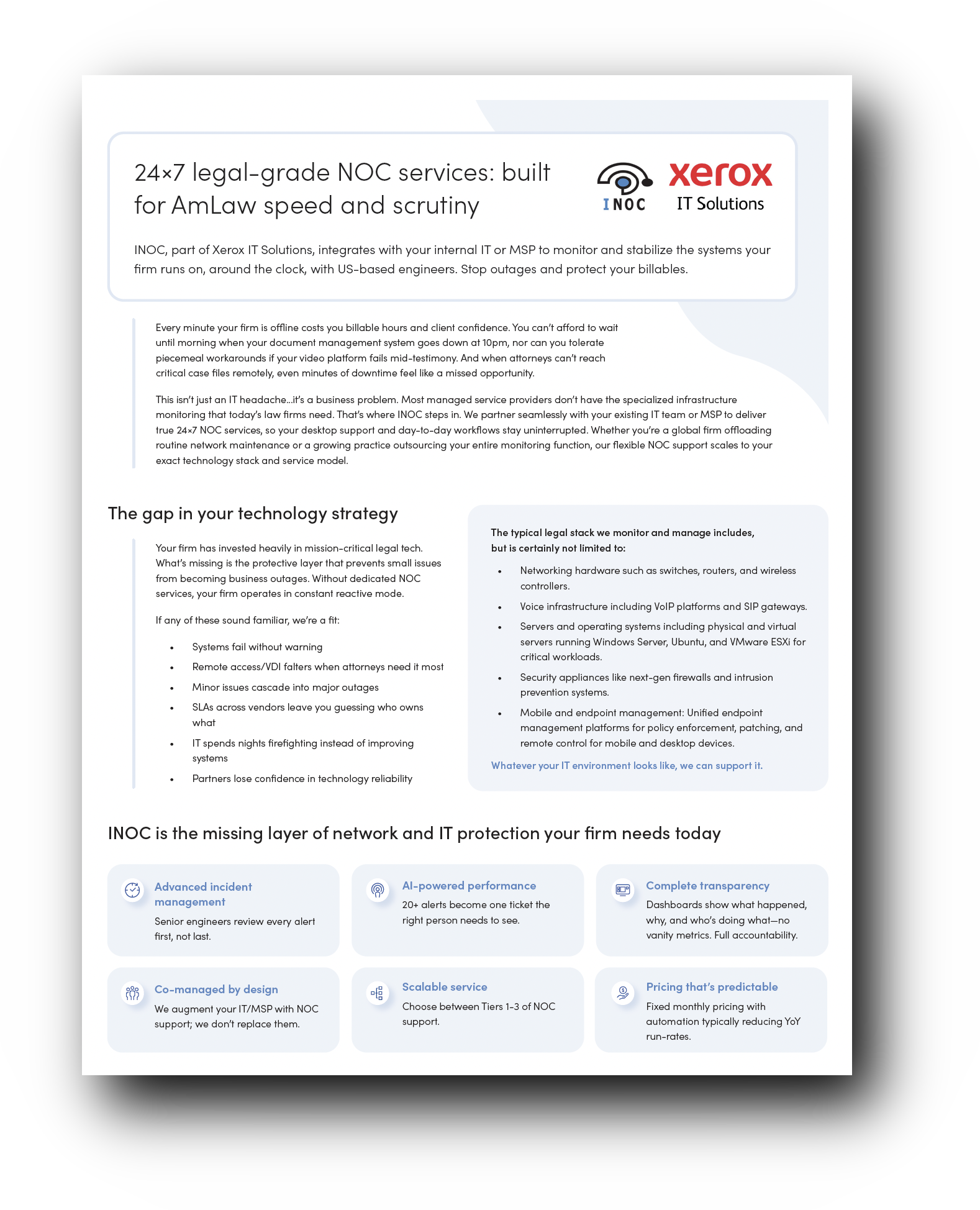
NOC Services for Law Firms Download our NOC service explainer for law firms
Looking for a NOC service provider? Download and circulate our service sheet for a quick rundown of how we help legal service firms.






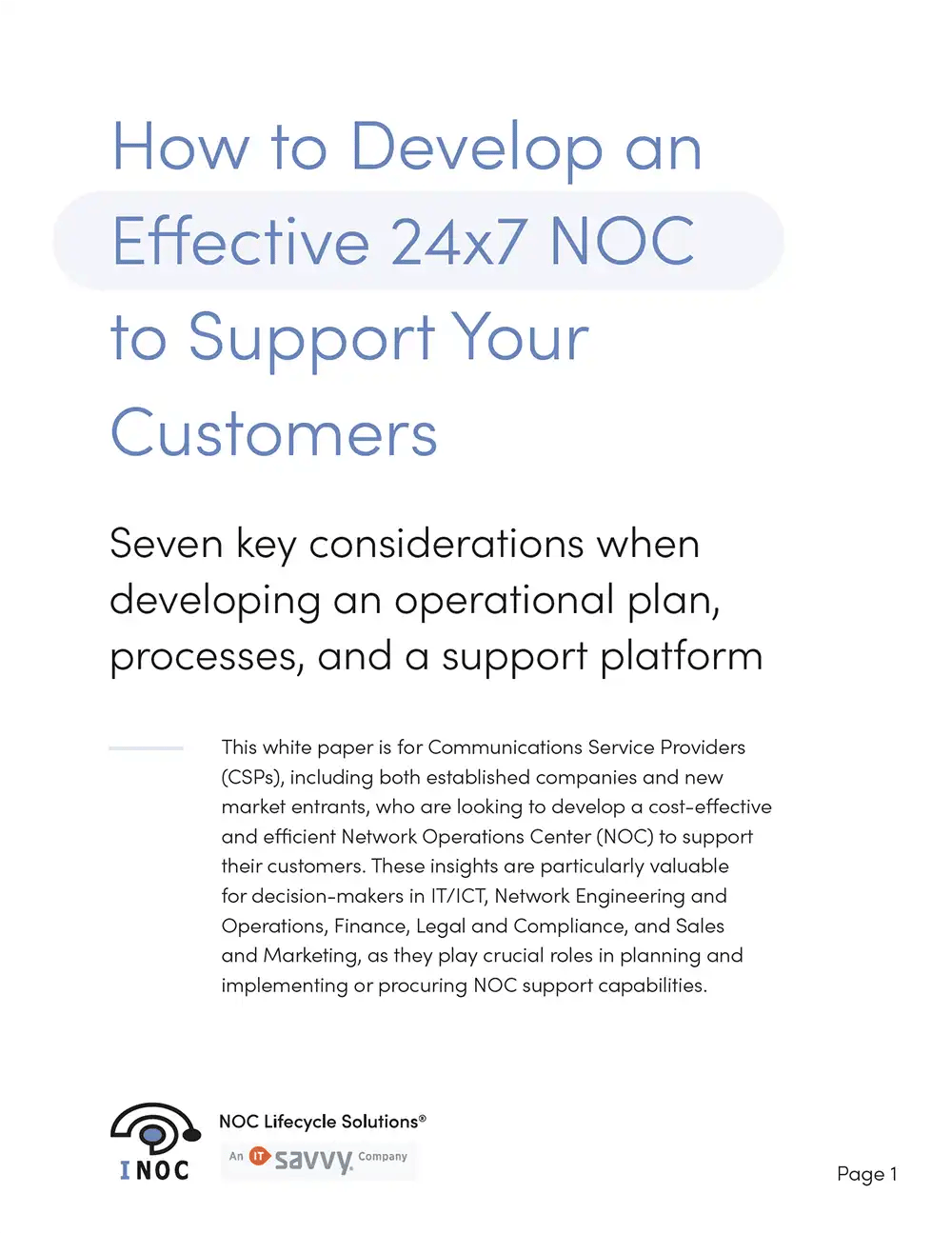

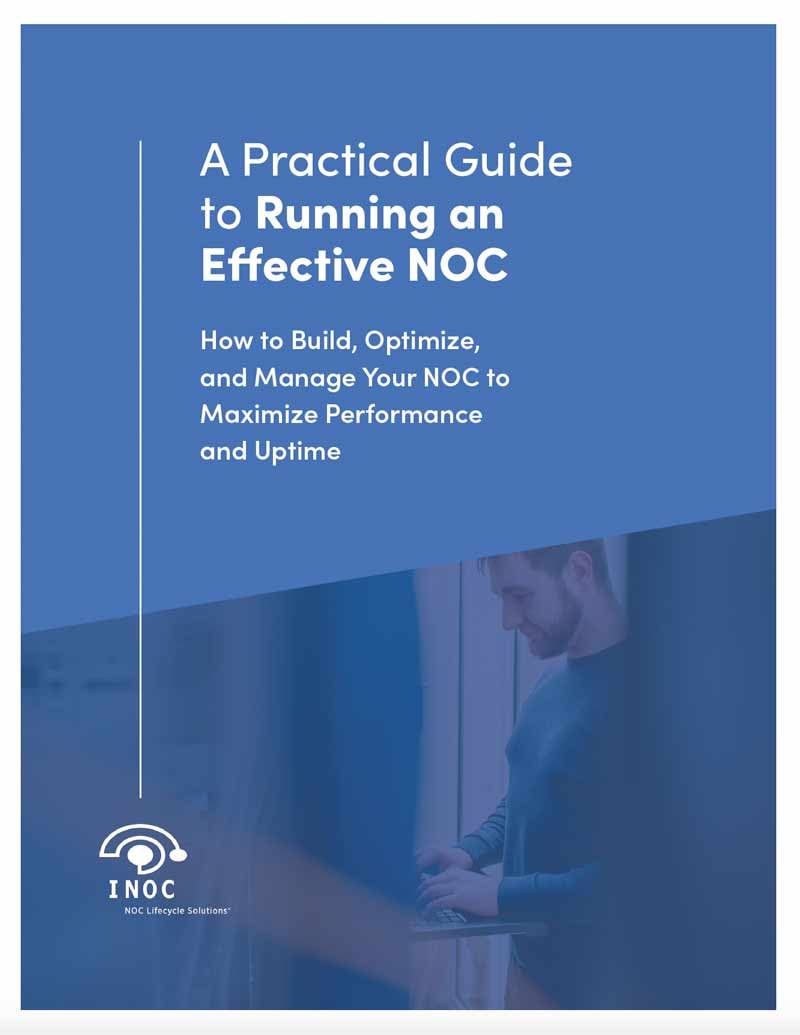
-images-0.jpg?height=2000&name=ino-WP-NOCPerformanceMetrics-01%20(1)-images-0.jpg)



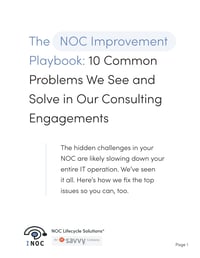

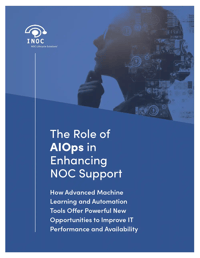

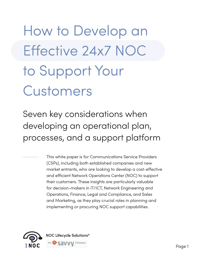
-images-0.jpg?width=200&height=259&name=ino-WP-NOCPerformanceMetrics-01%20(1)-images-0.jpg)